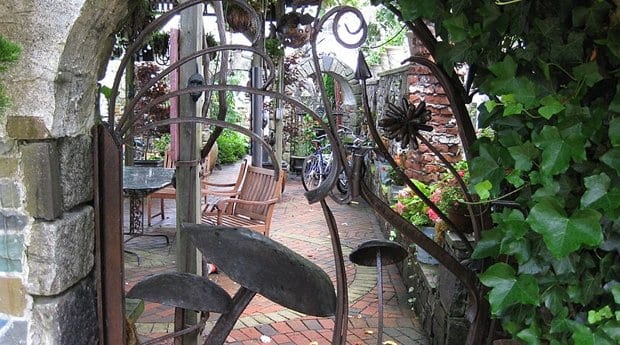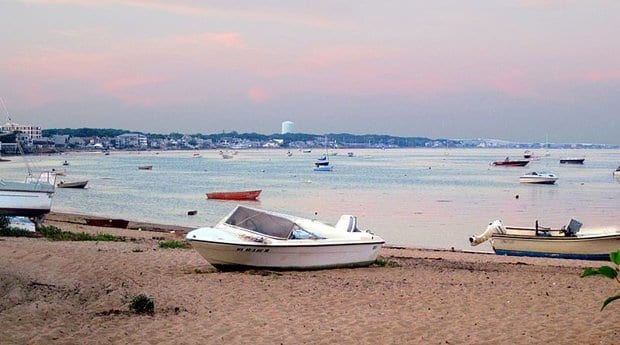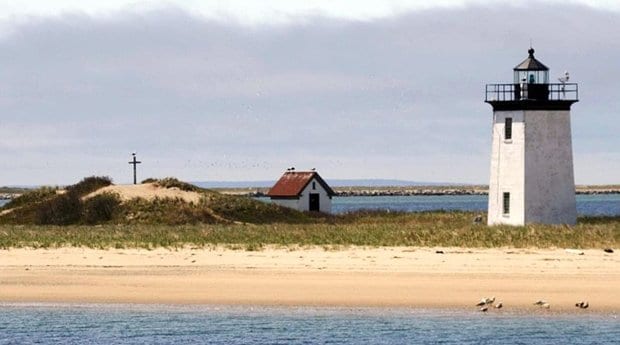
Explore and discover quiet, out-of-the-way patios, like this one just off Commercial Street. Credit: Seduisant

Skip Commercial Street and take a quiet stroll along the beach. Credit: DB King
With the season in full swing in Provincetown, visitors who are sensitive to crowds might find themselves desperate for some down time away from the hordes. But one of the appealing things about the town, and Cape Cod in general, is how easy it is to get away from it all — and how close that escape is. Here are 10 suggestions.
1. Walk along the beach instead of Commercial Street
You’ll always find someone walking a dog, sunbathing or wading in the calm harbour water, but the town beach is never crowded. It’s especially beautiful at the end of the day, when the last bits of light play magic tricks with the moored boats. The sight of a red-and-white dory on the blue water will give you a visceral understanding of why the town is the United States’ oldest continuous art colony.
Take a detour out MacMillan Wharf, past the whale-watching boats, pleasure craft and fishing boats. At the far end you’ll have a great view of town and an outdoor art installation on the next pier called They Also Faced the Sea, five large portraits of local Portuguese-American women.
2. East End art galleries
Sometimes escaping is as easy as getting out of the town centre in either direction. The east end is where the galleries are concentrated. This is where painter Charles Hawthorne established the Cape Cod School of Art in the early 1900s, then the Provincetown Art Association, now home to an impressive collection, including a number of sculptures on the front lawn of the rambling old building. Such artists as Mark Rothko, Jackson Pollock and Robert Motherwell were drawn to the grand old houses that once belonged to ships’ captains. So was playwright Eugene O’Neill, who lived in town for eight years and whose first play premiered on a long-gone fishing wharf in the east end.
3. West end garden tour
The whole town is chockablock with gorgeous gardens, which do very well in the moist, temperate climate, but those in the west end have an extra something — maybe because it’s considered the “gayer” end of town? For a town whose native topsoil long since blew away — after the early settlers clear-cut the trees for building and fuel — its inhabitants do wonderful things with their tiny yards and trucked-in dirt. The west end used to be the “wrong” side of town, so its houses are much less grand and more squeezed together than those in the east end, but today that’s part of its charm.
4. The breakwater/Long Point/the salt marsh
Looking out from the beach in the west end you’ll see Long Point, the very tip of the Cape and one of its most secluded beaches. Unless you hire Flyer’s water taxi to take you over, the only way to get there is by walking across the breakwater, which starts at the roundabout at the end of Commercial Street.
A jumble of granite blocks constructed in 1911, the breakwater is fun to walk across, but wear sensible, non-slip footwear: it’s a mostly gentle walk, but there are a few tricky, sometimes slippery spots. It takes about an hour to cross over and walk the beach to the tip or hike to the far side, through the dune grass (watch out for the poison ivy, with its shiny, three-leafed clusters). There are also some great places to rest or hang out on the breakwater. If you go about an hour before high tide, you can slip into the water and be carried along by the tide (look for the path of the slipstream where the sea grass doesn’t grow).
In the 1700s, Long Point was an isolated community of fishing and salt-works families. In the mid-1800s, with salt sales dropping, 48 homes were floated to the mainland, most of them to the west end. They can be identified by the blue and white historical plaques by their front doors.
The salt marsh, to your right as you walk out the breakwater, is gorgeous at any time of the day: when the tide’s coming in or going out, the view changes from minute to minute. At low tide, innumerable tidal pools make for a fascinating walk — but watch out for the tide, because it comes in quickly!
5. The quiet end of Herring Cove
Beyond the salt marsh are the dunes that mark the beginning of Herring Cove; look for the spot on the road, just past the point where Commercial loops around and becomes Bradford, where the boys lock their bikes — this is the start of the trail to the beach. And this is gay men’s country (the lesbians hang out closer to the parking lot; the joke is that gay men go to the beach with their bathing suits and towels, while lesbians take as much as possible). Stay on the path, since this is a fragile landscape, for the 15-minute walk; at high tide, you might have to wade for a bit. As you near the beach, you’ll notice various paths branching off from the main one — at low tide they get very cruisey.
Keep in mind that public nudity is illegal. The park rangers don’t always enforce the rule on the hard-to-reach portions of the seashore, but closer to the parking lots they’re likely to be stringent. If you’re au naturel, be prepared to pull on a top (girls) or some shorts (girls/boys) if you hear someone call “Ranger!”
6. Hatches Harbor
You might want to avoid the stretch of Herring Cove on the other side of the lesbians — that’s primarily straight territory. If, however, you make your way past all the RVs lined up in the far parking lot and strike out along the beach, you’ll find a remarkably peaceful setting. The only way to get to Hatches Harbor is to walk, so even in the height of summer it’s possible to have this stretch of beach to yourself. If you set up close to the water, be aware of the tides: some spots turn into sandbars that are quickly cut off from shore.
7. The bike paths
There are 12 kilometres of bike paths between town and Race Point, and they’re a great way to get out in the dunes. Pick up the path at the far end of the Herring Cove parking lot. In places, the landscape is almost pure sand; elsewhere, it’s covered in scrub brush and stunted, twisted pine trees. Follow the path through the beech forest, one of the few places in the 3,500-acre Province Lands with extensive tree cover. If you stay on the main loop, you’ll eventually make your way back into town. A left turn at the sign will take you out to Race Point; when the moon’s full or close to it, a nighttime ride out here is magical. Be careful on corners, though: the ever-shifting dunes sometimes encroach on the paths.
8. Race Point at sunset
Race Point Beach is much more spectacular — and much less stony — than Herring Cove, aside from its relative absence of beautiful gay men and sporty lesbians. It’s straighter and farther from town, and the parking lot fills up early in the summer, but at the end of the day, when the families have packed up and gone, it’s sparsely populated and a fantastic place to watch the sunset. In this it can’t compete with the west-facing Herring Cove, but the romance of the setting makes up for that. Take a blanket, a sweater, a picnic and some wine (it’s not strictly legal, but if you’re discreet, no one should bother you), and settle in for the show.
9. Snail Road dunes
For a true getaway, pack a lunch and some water and head out into the dunes. Park your car or bike at the end of Snail Road, on the east end of town (there’s a pull-off to the side of Route 6 with room for several cars), then head in the trail through the trees; a short walk will take you to an otherworldly landscape, with the dunes stretching ahead and to your left and right. The big, barren mass in front of you that looks like something out of Lawrence of Arabia is called Mt Ararat. Climb to the top, from which you can see Provincetown Harbor behind you and the Atlantic straight ahead. (This is a good time to note the spot in the trees from which you emerged so you can find the path later; it’s remarkably easy to get lost in this expansive landscape.)
By all means, indulge your inclination to run full tilt down the sandy sides of Ararat, but avoid the dune grass as much as you can: it’s deliberately planted to stabilize the dunes and stem the constant erosion of the sand.
On your 45-minute walk to the ocean, you’ll notice a number of tiny, quirky shacks scattered along the outermost ridge of dunes. A number of them were built, using washed-ashore lumber, in the 1920s; 19 remain. When John F Kennedy designated all of Cape Cod part of the National Seashore in 1961, they came under the care of the National Park Service; since 1989 they have been included in the National Register of Historic Places. Beloved by artists and writers and those wanting to live close to nature — Eugene O’Neill, John Dos Passos, Mark Rothko, Norman Mailer and Jack Kerouac all spent time in them — they are the opposite of luxurious, with no electricity, no running water and no phone service. Some are still privately owned; others are maintained by non-profit trusts that offer summertime artists’ residencies. You’ll be tempted to peek inside, but admire the shacks from afar — the people who stay in them do so because they really want to be alone.
10. Freshwater ponds
Unknown to many are the Cape’s 300 or so freshwater ponds, the perfect escape from the crowded shorelines and a great way to rinse off the salt water after a day on the beach. While some sit in plain sight, others are hidden well away from the roads. Finding them can be tricky: unlike the ocean beaches there are no signs, and locals don’t usually reveal their whereabouts. Years ago, I was lucky enough to be shown the way to one in Truro; its unofficial name was Secret, Secret Pond.
Some of the larger ponds have parking, but a resident’s sticker is required; for others, all you need is to know where to stop and which dirt path to follow. The best way to find them, especially the out-of-the-way ones, is with a good local map, or perhaps Google Earth.
• • •
Of course, if you really wanted to miss the crowds you’d go to P’town in the off-season or winter (when the Cape is beautiful in a very different way). So once you’ve had some alone time, put on your fancy pants and head out for all the fun and activity that the Commercial Street carnival has to offer. Last call’s at 12:45.

 Why you can trust Xtra
Why you can trust Xtra